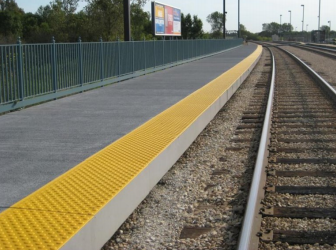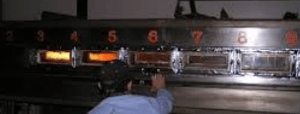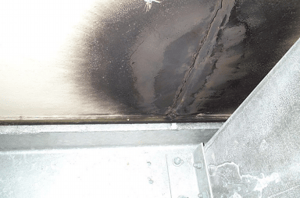Fire Resistance of FRP Rail Platforms
 Fire resistance of Fiber Reinforced Polymer panels is always a question in discussions of rail platforms. Most polymers will burn in the presence of an active flame. The polymers used FRP platform panels have been formulated to minimize flame spread and be self-extinguishing when the flame is removed. The governing codes allow for these FRP materials to be used for open air stations.
Fire resistance of Fiber Reinforced Polymer panels is always a question in discussions of rail platforms. Most polymers will burn in the presence of an active flame. The polymers used FRP platform panels have been formulated to minimize flame spread and be self-extinguishing when the flame is removed. The governing codes allow for these FRP materials to be used for open air stations.
Governing Codes
National Fire Protection Association (NFPA)
NFPA 130 -2010 “Standard for Fixed Guideway Transitand Passenger Rail Systems”- Enclosed stations shall be not less than Type I or II noncombustible construction as defined in NFPA 220, Section 5.2.2.1
- Other types of construction as defined in NFPA 220 Section 5.2.2.2 shall be permitted for open stations
- Type I is Fire Resistive. Concrete is an example of this type.
- Type II is Noncombustible. Steel is an example of this type.
- Type III is Standard. Most FRP materials are this type.
Limited Combustible Material is a sub-category of Type III and FRP materials are in this category.
Engineering Hazard Analysis to Evaluate Type III FRP Materials in a Rail Platform
Engineering analysis in accordance with NFPA 130.
Fire Scenarios: 1) Fire under the platform; 2) Train fire car fire; 3) Brake fire on train car
Conditions: Open air station does not trap smoke or hot gas. Occupants can travel to exits. Case Study for Station Currently in Design: Platform is 780 feet x 22 feet and is 4 feet above ground level. It holds 1695 occupants. There are four egress paths (2 stairs to bridges and 2 ramps.)

Egress Time: At a pedestrian walking speed of 2.5 mph, all the occupants clear the platform in 4 minutes
Burning Characteristics of FRP Platform: With an FRP materials with a Class A flame spread rating, the flame spreads at 0.01 mph. The flame travels less than 6 feet from ignition source during the four minute egress time.
There is ample time for the occupants of the platform to evacuate to a safe location.
Categories, Ratings and Testing
Material categories
The NFPA 220 categories are based on testing per ASTM E 136, Standard Test Method for Behavior of Materials in a Vertical Tube Furnace at 750°C.
Most FRP materials are rated Type III B Standard Material. Within this type, there is a category considered “Limited Combustible Material.” Some FRP materials are in this category.
Some FRP materials are Type II B Noncombustible Material. These include a specialty polymer; standard polymers with a high concentration of additives; and materials with intumescent coatings. The costs of these materials is much higher than the Type III B material. This adds a price premium that makes competing with concrete very difficult when a Cost Benefit Evaluation is performed.
Flame Spread Index
 Flame Spread Index (FSI) testing is the standard test used for qualifying materials for interior finish in the model building codes. The Flame Spread Index (FSI) considers both the ignition time and the distance that the flame front travels during the 10-minute test. It is determined using the ASTM E-84 tunnel test by burning the surface of a material.
Flame Spread Index (FSI) testing is the standard test used for qualifying materials for interior finish in the model building codes. The Flame Spread Index (FSI) considers both the ignition time and the distance that the flame front travels during the 10-minute test. It is determined using the ASTM E-84 tunnel test by burning the surface of a material.
The FSI is a relative number to an FSI of 0 for cement board, and an FSI equal to 100 for select grade red oak.
The FSI number is always rounded to the nearest multiple of 5.
Class 1 or Class A Flame Spread Index refers to a FSI of ≤ 25.
Class 2 or Class B refers to a laminate with a FSI of 30-75.
Class 3 or Class C refers to a FSI of 80-200.
FRP material ratings
There are different types of polymers engineered with different levels of fire resistance that can be used in FRP composites. Most FRP materials are Class B or C with a select number of polymers rated as Class A. Composite Advantage uses a Class A polymer for its rail platforms. It has an FSI of 25. The panel internal structure uses a closed cell foam core in its sandwich structure. It has a Class A Flame Spread Index
Real World Experience
 Case history is an FRP Vehicle Bridge Deck in Clark County, Ohio
Case history is an FRP Vehicle Bridge Deck in Clark County, Ohio
Vandals used a propane torch in an attempt to burn the bottom of an FRP deck.
The exterior coating burned off and the outer surface of resin was scorched. The high density of fiberglass reinforcement in the panel exterior facing acts as barrier against damage penetration into the panel. Inspection showed that the structural laminate was not damaged.

